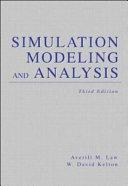
Graphical simulation modeling and analysis
using SIGMA for Windows
Sigma's advantages in simulation modeling are put to best use in this text/software package specifically designed for simulations courses using a Windows interface. Includes: -- All Sigma-generated code -- users can access and control all library functions for event list management, time advance, random variable generation, output, and stat collection. -- Sigma-facilitated team modeling -- users are able to individually create components of a system and then easily wire them together. -- Parametrized graphs -- allow the simultaneous running of parallel independent replications of the same simulation on the same CPU. -- Run-time editing -- allows event vertices and edges to be edited, added, replayed, executed, canceled, and deleted during a run, with instant replay.
- ISBN 13 : 9780877097822
- ISBN 10 : 0877097828
- Judul : Graphical simulation modeling and analysis
- Sub Judul : using SIGMA for Windows
- Pengarang : Lee W. Schruben,
- Kategori : Computers
- Penerbit : Boyd & Fraser Pub Co
- Klasifikasi : 003/.35369
- Call Number : 003/.35369 LEE g
- Bahasa : en
- Penaklikan : xxi, 298 p. :
- Tahun : 1995
- Halaman : 298
- Halaman : 298
- Open Library : http://openlibrary.org/books/OL1089960M/Graphical_simulation_modeling_and_analysis
- Google Book : http://books.google.com/books?id=GwMSAQAAMAAJ&dq=intitle:simulation+modeling+%26+analysis&hl=&source=gbs_api
-
Ketersediaan :
Sigma's advantages in simulation modeling are put to best use in this text/software package specifically designed for simulations courses using a Windows interface.






